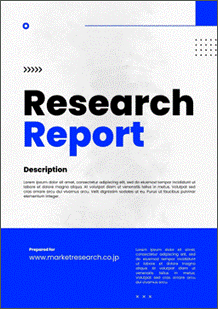 | • レポートコード:D0-MOR-AP0062 • 出版社/出版日:Mordor Intelligence / 2020年4月20日 • レポート形態:英文、PDF、182ページ • 納品方法:Eメール(受注後2-3営業日) • 産業分類:農業 |
| Single User | ¥629,000 (USD4,250) | ▷ お問い合わせ |
| Team User | ¥703,000 (USD4,750) | ▷ お問い合わせ |
| Corporate License | ¥1,110,000 (USD7,500) | ▷ お問い合わせ |
• お支払方法:銀行振込(納品後、ご請求書送付)
レポート概要
| 本調査レポートは、アルファルファ乾草の世界市場について調査・分析した資料で、アルファルファ乾草の市場概要、動向、セグメント別市場規模、地域別分析、競争状況、企業情報、市場機会分析などで構成されています。 |
Market Overview
– The global consumption of alfalfa hay was 197.8 million metric ton in 2018, and it is expected to register a CAGR of 6.9% during the forecast period (2019-2024).
– North America is projected to be the largest market for alfalfa hay. China, UAE, and Saudi Arabia are major importers of alfalfa hay from the US. The US and Spain are major exporters of alfalfa hay, globally.
– Use of alfalfa hay has become critical to poultry feed, followed by animal feed in recent years, due to its importance for crude protein content. Dependence on alfalfa hay for animal feed may continue to drive the alfalfa hay market, globally, over the forecast period.
Scope of the Report
Alfalfa hay is obtained from the Alfalfa plant, which is also known as Lucerne and Medicago Sativa. It is cultivated as an important forage crop in many countries around the world.
Key Market Trends
Increasing Demand for Dairy and Meat Products
Livestock is a major factor responsible for the growth of the alfalfa hay market. Annual growth of meat production and milk production in the developing countries is projected to be 2.4% and 2.5%, respectively, till 2030. This is expected to increase the developing countries’ share in the world meat production to 66% (247 million metric ton) and in milk production to 55% (484 million metric ton). Furthermore, there has been immense pressure on the livestock sector to meet the increasing demand for high-value animal protein.
The demand for alfalfa hay is increasing significantly in China and is driven due to changing production practices in the Chinese dairy industry. This is essentially due to the increasing number of cows raised by modern dairy farmers who prefer using imported hay and commercial feeds. Furthermore, the Chinese government is focusing on boosting the domestic production of alfalfa hay, in order to meet its high demand. The dairy sector is essentially boosting the demand for alfalfa hay in China. The country has about 15 million cows in the dairy industry, among which, 1.5 million are high producers (nine-ton annual milk yield).
North America to Dominate the Global Market
Some of the alfalfa hay producing states in the United States, as of 2017, are California (5,175 thousand metric ton), Idaho (4,400 thousand metric ton), Montana (3,150 thousand metric ton), and Minnesota (2,610 thousand metric ton). These account for nearly 27% of the alfalfa hay production in the country. China, Japan, Saudi Arabia, and the United Arab Emirates are the top export destinations to the United States, and China is expected to remain as the key market for the US alfalfa hay exports in the near future and almost half of the exports of alfalfa hay is to China. The domestic production of alfalfa hay in Saudi Arabia decreased. As the country needs to satisfy its dairy market demand for alfalfa hay, it mainly relies on imports and is also expected to remain as one of the key buyers from the US alfalfa hay market.
Competitive Landscape
The alfalfa hay market is highly fragmented. Alfalfa hay supply is concentrated in the United States and Spain, and consumption is concentrated in China, Japan, UAE, and Saudi Arabia.
Reasons to Purchase this report:
– The market estimate (ME) sheet in Excel format
– Report customization as per the client’s requirements
– 3 months of analyst support
1 INTRODUCTION
1.1 Study Deliverables
1.2 Study Assumptions
1.3 Scope of the Study
2 RESEARCH METHODOLOGY
3 EXECUTIVE SUMMARY
4 MARKET DYNAMICS
4.1 Market Overview
4.2 Introduction to Market Drivers and Restraints
4.3 Market Drivers
4.4 Market Restraints
4.5 Industry Attractiveness – Porter’s Five Forces Analysis
4.5.1 Threat of New Entrants
4.5.2 Bargaining Power of Buyers/Consumers
4.5.3 Bargaining Power of Suppliers
4.5.4 Threat of Substitute Products
4.5.5 Intensity of Competitive Rivalry
5 MARKET SEGMENTATION
5.1 Type
5.1.1 Bales
5.1.2 Pellets
5.1.3 Cubes
5.2 Application
5.2.1 Meat/Dairy Animal Feed
5.2.2 Poultry Feed
5.2.3 Horse Feed
5.2.4 Other Applications
5.3 Geography
5.3.1 North America
5.3.1.1 US
5.3.1.2 Canada
5.3.1.3 Mexico
5.3.1.4 Rest of North America
5.3.2 Europe
5.3.2.1 UK
5.3.2.2 France
5.3.2.3 Spain
5.3.2.4 Italy
5.3.2.5 Rest of Europe
5.3.3 Asia-Pacific
5.3.3.1 China
5.3.3.2 Japan
5.3.3.3 India
5.3.3.4 Australia
5.3.3.5 Rest of Asia-Pacific
5.3.4 South America
5.3.4.1 Brazil
5.3.4.2 Argentina
5.3.4.3 Rest of South America
5.3.5 Middle East and Africa
5.3.5.1 South Africa
5.3.5.2 UAE
5.3.5.3 Saudi Arabia
5.3.5.4 Rest of Middle East and Africa
6 COMPETITIVE LANDSCAPE
6.1 Vendor Market Share
6.2 Mergers and Acquisitions
6.3 Company Profiles
6.3.1 Al Dahra ACX Global Inc.
6.3.2 Alfalfa Monegros SL
6.3.3 Anderson Hay & Grain Inc.
6.3.4 Bailey Farms
6.3.5 Border Valley
6.3.6 Coaba
6.3.7 Cubeit Hay Company
6.3.8 Glenvar Hay
6.3.9 Green Prairie International
6.3.10 Grupo Osés
6.3.11 Gruppo Carli
6.3.12 Hay USA
6.3.13 Haykingdom Inc.
6.3.14 Knight AG Sourcing
6.3.15 Los Venteros SC
6.3.16 M&C Hay
6.3.17 McCracken Hay Company
6.3.18 Riverina (Australia) Pty Ltd
6.3.19 SL Follen Company
6.3.20 Standlee Hay Company
7 MARKET OPPORTUNITIES AND FUTURE TRENDS